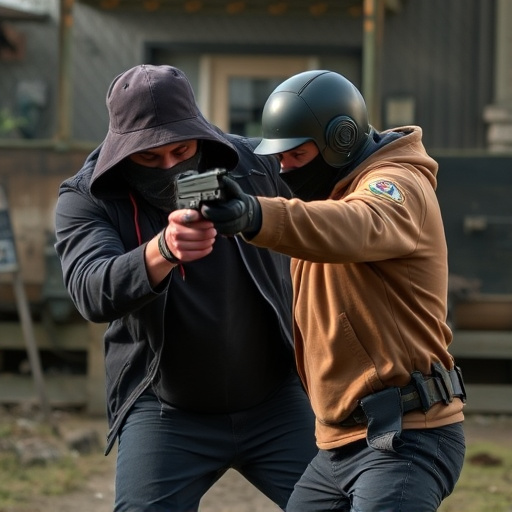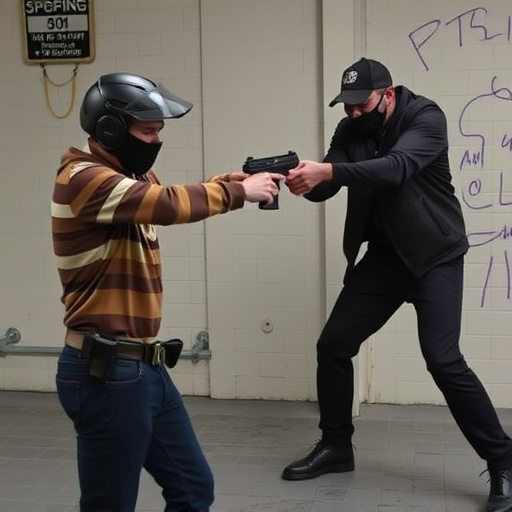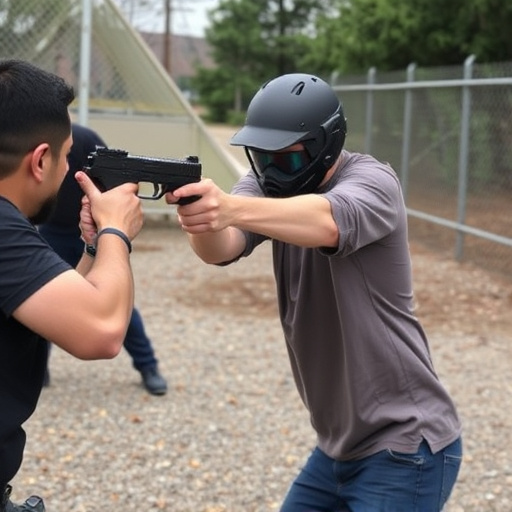Tasers and stun guns are non-lethal electronic control devices (ECDs) that temporarily incapacitate through electrical pulses. Tasers disrupt muscle control with low-current, high-voltage pulses aimed at specific zones, while stun guns deliver a single, high-voltage pulse. Proper charging techniques, following manufacturer guidelines, are crucial for both to ensure maximum shock intensity and safety. Stun guns require careful handling due to their high voltage, and legal usage varies by jurisdiction; seeking proper training is essential before use. For reliable self-defense or professional applications, understanding how to charge a stun gun properly is key.
In the realm of personal defense, Tasers and stun guns stand out as popular choices. Understanding their nuances is crucial for informed decisions. This article delves into the inner workings and practical applications of both devices. We explore the mechanism of Tasers, unlocking the secrets of stun guns, and highlighting key differences in safety, effectiveness, and legal considerations. Additionally, we guide you on the essential yet often overlooked aspect: learning how to charge a stun gun properly.
- Understanding Tasers: Mechanism and Usage
- Unlocking Stun Guns: Features and Charging Techniques
- Key Differences: Safety, Effectiveness, and Legal Considerations
Understanding Tasers: Mechanism and Usage

Tasers, officially known as Electronic Control Devices (ECDs), are non-lethal weapons designed to temporarily incapacitate a person through electrical pulses rather than physical force. They work by delivering a strong electric current through two probes connected to the device, disrupting muscle control and causing temporary paralysis. This disruption is typically brief, lasting anywhere from a few seconds to a minute, depending on the model and the user’s body type.
Proper usage of a taser involves aiming for specific target zones, such as the thigh or side, where the probes will make contact with the subject’s skin but minimize the risk of permanent injury. It’s crucial to receive proper training in how to charge a stun gun correctly and deploy it safely, focusing on neutralizing a threat rather than causing lasting harm. Unlike traditional firearms, tasers require no ammunition, making them a preferred option for self-defense situations where non-lethal force is appropriate.
Unlocking Stun Guns: Features and Charging Techniques

Stun guns, also known as electronic control devices (ECDs), are designed to incapacitate a target with an electric shock, rendering them non-threatening for a period of time. Unlocking their potential requires understanding key features and efficient charging techniques. These weapons typically use high-voltage, low-current electrical pulses delivered through probes or electrodes, causing muscle contractions and disorientation in the target.
Proper charging is essential for optimal performance. Most stun guns operate on rechargeable batteries, similar to those found in flashlights or toys. Users must regularly how to charge stun gun properly by following manufacturer guidelines. This often involves plugging the device into a standard charger or using specialized charging equipment. Adequate charging ensures the stun gun delivers its maximum shock intensity when needed, making it a reliable tool for self-defense and law enforcement applications.
Key Differences: Safety, Effectiveness, and Legal Considerations

When comparing a Taser and a stun gun, understanding their key differences is crucial for informed decision-making, especially considering safety, effectiveness, and legal aspects. One prominent distinction lies in their operation; a Taser uses electrical current to disrupt muscle control, while a stun gun delivers a high-voltage pulse to temporarily disable the target. This difference has implications for user safety and potential outcomes.
Regarding safety, proper usage and knowledge of how to charge a stun gun are essential. Improper charging can lead to malfunction or even cause harm. In contrast, Tasers are generally more controlled in their deployment due to their design, which requires training and adherence to manufacturer guidelines. Legally, the use of both devices varies by jurisdiction, with some areas having stricter regulations on stun guns compared to Tasers. Thus, understanding local laws and seeking proper training is vital before considering either for self-defense or professional applications.
Tasers and stun guns are both non-lethal weapons designed for personal protection, but they differ significantly in their operation and effectiveness. Tasers use electrical pulse technology to disrupt muscle control, while stun guns emit a powerful electric discharge. In terms of safety, stun guns generally have lower voltage settings, making them less likely to cause serious harm to bystanders. Effectiveness varies; tasers are known for their range and ability to incapacitate multiple targets, whereas stun guns offer a shorter-range but potent strike. Legal considerations also differ, with regulations dictating the use and carrying of each device. For those seeking personal protection, understanding these differences is crucial when choosing between a taser or a stun gun, especially with proper charging techniques for stun guns, to ensure they are fully prepared.
